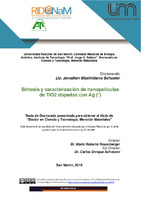Síntesis y caracterización de nanopelículas de TiO2 dopadas con Ag (*)
Abstract
En el marco del desarrollo de una nueva prótesis valvular cardíaca y habiéndose seleccionado como material para su construcción una aleación de Ti-6Al-4V recubierta con una película de óxido de titanio, en la presente Tesis Doctoral se aborda el estudio de la combinación de técnicas de oxidación anódica y sol gel por inmersión para la obtención de las películas de TiO2 dopadas con Ag y con tratamiento UV. Las películas para este tipo de dispositivos deben ser resistentes al desgaste, hemocompatibles y de ser posible con propiedades antibacterianas. En este trabajo se sintetizaron películas de TiO2 dopadas con plata y sin dopar, en un proceso de dos capas, primeramente, un proceso de anodización para buscar resistencia mecánica y luego un recubrimiento de sol-gel por inmersión, se logró incorporar plata a la película usando nitrato de plata en la preparación del sol. También, se evaluó el postratamiento con radiación UV-C. Luego se caracterizaron las películas obtenidas, en cuanto a: rugosidad, morfología, espesor, estructura cristalina, mojabilidad y energía libre superficial. Experimentalmente se evaluó la resistencia al desgaste (mediante un equipo ball-on-flat reciprocante), la actividad antibacterial contra Staphylococcus aureus (mediante el ensayo de halo de inhibición, ensayo de adhesión y proliferación y ensayo de adhesión, proliferación y supervivencia) y la hemocompatibilidad (mediante el ensayo de adhesión de plaquetas). Mediante la teoría de coloides extendida se modeló la interacción del S. aureus, proteínas plasmáticas y eritrocitos con las películas. Además, mediante una aproximación termodinámica (cálculo de tensión interfacial) se analizó la interacción entre proteínas plasmáticas y la sangre con los materiales. Los resultados del modelado se contrastaron con los resultados experimentales encontrando buena correlación entre ellos. Las películas de TiO2+Ag+UV presentaron una alta resistencia al desgaste, capacidad de inhibir el crecimiento del S. aureus, menor adhesión de S. aureus, inhibición de la proliferación del S. aureus adherido y una buena hemocompatibilidad. Por lo que, la combinación de técnicas (anódica y sol gel) y tratamientos (UV) podría ser la más adecuada para la obtener películas de TiO2+Ag+UV sobre la prótesis valvular cardíaca. In the aim of the development of a new prosthetic heart valve made of Ti-6Al-4V with a coating titanium oxide film, has lead to in the present doctoral thesis is focused in the study of the combination of anodic oxidation and sol-gel dip coating techniques to obtain titanium oxide films doped with silver and an ultraviolet treatment. In such case the films used in these devices should will be wear resistant, hemocompatible and with antibacterial properties. In this work, Ag-doped and non-doped TiO2 films were synthetized, in a two-steps process: in a first film was produced by an anodizing process, to confer mechanical resistance, and second a sol-gel dip-coating containing silver nitrate to introduce Ag in the film as dopant. Besides, a post treatment with UV-A radiation was carried out and its effect evaluated. The films obtained were characterized by measuring of roughness, surface morphology, thickness, crystalline structure, wettability and surface free energy. Experiments to evaluate wear resistance using a reciprocating ball-on-flat equipment were performed. The antibacterial activity to Staphylococcus aureus through the inhibition halo trial, adhesion-proliferation trial, and adhesion-proliferation-survival trials were analyzed. The hemocompatibility through the platelets adhesion trial were analyzed. Using the extended colloids theory, the interaction of the films with: S. aureus, plasma proteins and erythrocytes were modeled. Besides, using a thermodynamic approach (interfacial tension calculation), the interaction of the films with plasma proteins and whole blood were analyzed. The results were compared with the experiments finding good agreement. The films of TiO2+Ag+UV presented high wear resistance, high capacity to inhibit the growth of S. aureus, low adhesion of S. aureus, good inhibition of the proliferation of S. aureus adhered to the surface and good hemocompatibility. For that reasons, the combination of anodic oxidation with sol-gel together an UV-A treatment could be the most satisfactory coating for using in a prosthetic heart valve
Collections
- Doctorado [62]
The following license files are associated with this item:



